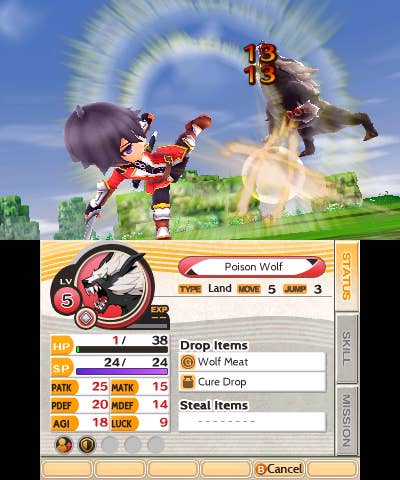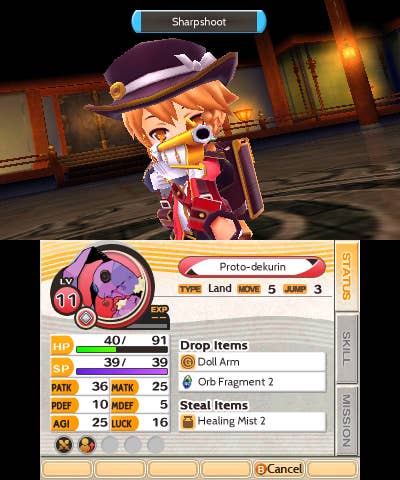Stella Glow Stands Out in a Season Overloaded with JRPGs
Atlus' low-profile release just might scratch your strategy RPG itch during this busy fall season.
This article first appeared on USgamer, a partner publication of VG247. Some content, such as this article, has been migrated to VG247 for posterity after USgamer's closure - but it has not been edited or further vetted by the VG247 team.
We Japanese RPG fans are really facing a monkey's paw scenario this fall, aren't we?
I mean, look at everything released since summer came to a close: Legend of Legacy, Yokai Watch, and Trails in the Sky SC—not to mention Xenoblade Chronicles X quietly waiting juuust around the corner. It's actually a relief Europe is getting Mario & Luigi: Paper Jam more than a month before we do—some of us need time to catch up, and not just with this year's slew of JRPGs. (I'll get back to you one day, Bravely Default.)

With almost too many choices concerning where to spend the next 40-60 hours, it's entirely possible you missed yesterday's 3DS release of Stella Glow. And I can't say I blame you—that title feels more appropriate for a floor cleaner than a fantasy RPG. But, despite its low profile, Stella Glow marks the end of an era for developer Imageepoch, which officially closed its doors in May after a decade working almost entirely in the portable space—a depressing sign of the times if there ever was one. Their swan song acts as a spiritual sequel of sorts to the Luminous Arc series of strategy RPGs, which were mostly unambitious, but still got the job done. And Stella Glow falls very much in line with its predecessors; it may not have the depth and customization of, say, Final Fantasy Tactics, but it certainly filled the Shining Force-shaped hole in my heart.
And "Shining Force" is probably the best way to describe how Stella Glow plays, as it feels very much like Sega's SRPG series did before it went on to... do whatever it's doing now. Throughout the course of the game, you amass an army of prescribed characters who possess prescribed skills, with the chance to grind through random battles along the way. And these battles play out exactly the way you'd expect them to, with turns, grid-based movement, elemental weaknesses, attack and defense bonuses from terrain and placement, and a timeline on the screen to show you who's acting next. If you've played any strategy RPG within the past 20 years, someone could drop you into Stella Glow mid-battle, and you wouldn't have any problems adapting to its reliable take on the genre.
That's not to say Stella Glow plays out completely like a 16-bit game, though. Taking a cue from Persona—as many RPG developers are doing these days—Stella Glow's world operates via a sort of clock that replaces the typical numbers with red and blue circles. The blue ones represent "Free Time," which give you a limited number of non-combat options to take part in, like earning money from part-time jobs, scrounging for supplies, and building social links with your team members in order to access new skills and abilities. When the clock ticks over to red, it's officially "Mission Time," which opens up the next story-related skirmish on the world map, along with other optional battles if you'd like to grind for experience. In keeping with Stella Glow's general approach, this time system isn't too ambitious, but it still allows for the player to to do more than simply play out battle after battle.
Stella Glow might be pretty by-the-numbers, but one thing I wasn't expecting—especially from a relatively low-budget developer like Imageepoch—was just how high-scale the production values would be. It's not on par with something like Monster Hunter 4 Ultimate, but Stella Glow still presents a visually attractive and colorful world with with great character animations—even if their in-battle models are reduced to a super-deformed state. The only real downside to Stella Glow can be found in its mostly bland story, which does what it can but feels wholly lifted from the Tales of series—right down to the clumsy attempts to deal with the issue of prejudice. If you're anything like me, you probably don't go into these fluffy, anime-style storylines expecting to be wowed, so I can't say I was disappointed or anything. To its credit, though, Stella Glow keeps its story scenes pretty economical in terms of dialogue.

Admittedly, Stella Glow may strike some as a bit too simple. But as someone who spent 100 hours on Tactics Ogre: Let Us Cling Together and probably three times that amount on Final Fantasy Tactics, I can say with confidence Stella Glow doesn't hold the same charms found in tinkering with the nearly endless options of a robust job system. Then again, what's presented here hits a certain "comfort food" spot, especially if you've spent the last couple of decades shuffling around tiny soldiers around grid-based environments. The prescribed characters and lack of customization may be a bit of a turn-off, but, regardless of complexity, there's still something incredibly rewarding about pushing to the end of a tough, turn-based battle through sheer strategery.

